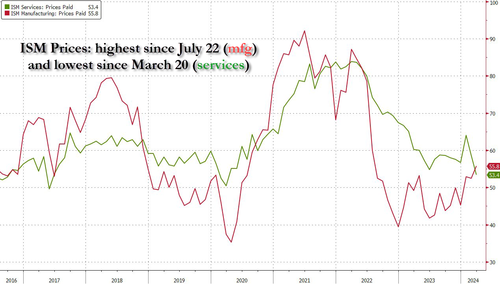


By Michael Every of Rabobank
Fed Chair Powell noted the FOMC will wait for a clearer signal from the data before starting rate cuts, which he continues to expect to begin “at some point this year.” In particular, he said that recent inflation data have not “materially changed” the bigger picture.
Battered bonds liked that message, bull flattening the curve; the US dollar, however, continues to batter many EM (and DM) FX, requiring higher, not lower, rates in response. Gold shone slightly brighter at a brief new high of $2,300, while Brent just failed to get back to a 9 handle at $89 and change at its intra-day high.
The latest data Powell dismissed were mixed. ADP employment was 183K vs. 150K expected, with a 10% y-o-y wage gain seen for job switchers: I recall a bond bull telling me in 2021 that they would believe inflation was back only if we got real pay-rises. Yet the ISM services survey was softer than expected and its prices paid component dipped to its lowest for four years and the employment sub-index remained below 50, showing job losses. That’s as goods inflation seemed to loom according to this week’s US ISM manufacturing survey.
To summarize, there was no material change to a US big picture which doesn’t make a lot of sense to many observers. Meanwhile, in Europe the opposite above-target CPI dynamic was confirmed, where services were stubbornly high at 4% y-o-y and the only crutch was goods deflation in food (not energy, which often drives food prices with a lag), and some industrial products (i.e., imports from China). Yet despite that big picture, the ECB has been even more dovish than the Fed in its recent statements.
Central banks are obviously determined to cut – or to make you think they are going to cut. It’s hard not to notice that rococo gilded frame if you take a step back to take it all in – which gold is very obviously doing. Yet the bigger ‘big picture’ is arguably that short of an economic downturn that no central bank expects, cutting rates could perhaps risk triggering a material, inflationary move higher in asset and commodity prices. Indeed, if real demand is going to pick up, which is the point of lower rates; and if financial speculation is going to pick up, which is why the market is focused on lower rates; and if the supply of some key goods and commodities is going to be an issue, then how does that rate-cuts = higher supply-side inflation backdrop not risk transpiring?
It would cause a major market shock if rate cuts didn’t happen; or if rates were cut anyway “because reasons/debt sustainability/populism slash elections.” But just because central banks can’t say this, as it would show the limits of what they can and can’t do in the real world, and those in markets who want higher asset prices obviously won’t, doesn’t mean it can’t hypothetically be the case. Indeed, the real world is still out there, and it’s very real right now.
Finally, in a related bigger picture of far more importance to central banks and financial markets than either wants to admit, the US is hardly inspiring geopolitical shock and awe in those willing to deliberately restrict supply of key goods and commodities to ensure the West can’t play the ‘low-rates/QE, and you give us your stuff’ game again. US President Biden’s on/off frailties are hardly news, but now…
US National Security Adviser Sullivan has postponed a planned trip to Saudi Arabia to discuss Saudi normalization with Israel, because he cracked his own rib in a "minor accident of his own" which "was not caused by anybody." Which sounds like the kind of things that the White House press secretary keeps having to say.
US Secretary of State Blinken was forced to abandon his Boeing 737 plane due to another technical issue with it, and instead take a long drive to a key NATO meeting. Our Fed-watcher Philip Marey, as sharp with his wits as he is with his Fed calls, quipped that perhaps reporters are stealing parts from official White House planes now, not just memorabilia.

